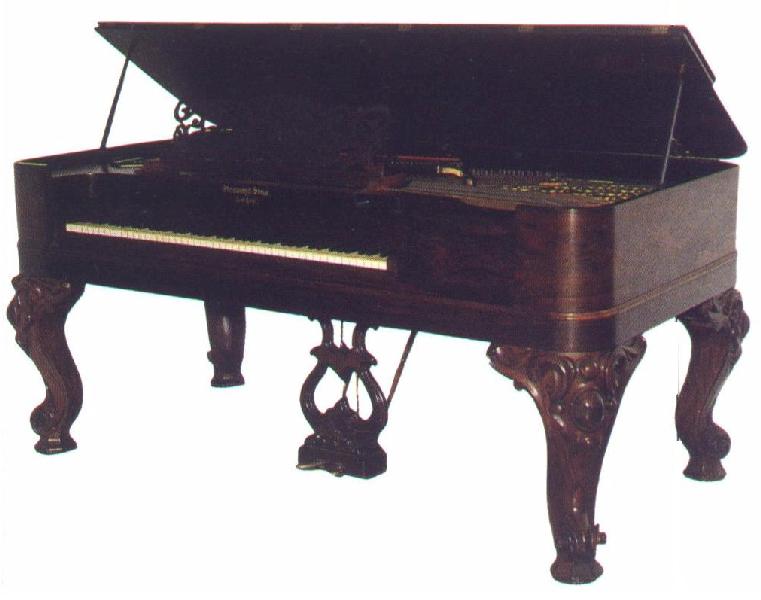The Square Piano

Click on image to get larger image
Johannes Zumpe & Gabriel Buntebart, London 1769. This square piano from Johannes Zumpe used his English single action with no escapement and no check, limiting its performance somewhat. This piano was typical of the basic, relatively low-cost instruments (around 15-20 pounds) with which Zumpe made his fortune. Zumpe and Gabriel Buntebart, a fellow German, were partners from 1768 to 1778. J.C. Bach, who was a friend of Buntebart's, used a similar instrument for the first public piano recital, in 1768. With the lid open the modifiers and their levers can be seen to the left side of the instrument. The dampers sit above the strings and are raised or lowered by the relevant lever. The right hand 'compartment' houses the single bridge and tuning pins.
 Steinway & Sons, New York, 1871. The way in which the square piano grew in size can be clearly seen in this powerful instrument from Steinway & Sons. Even the lid weighs more than those of most grand pianos. This design, with a full iron frame, is probably the most powerful type of square piano ever built. When the lid is raised, the sound is reflected directly at the player, further enhancing the power of the instrument--though not to the benefit of an audience, as with the lid of a grand.
Steinway & Sons, New York, 1871. The way in which the square piano grew in size can be clearly seen in this powerful instrument from Steinway & Sons. Even the lid weighs more than those of most grand pianos. This design, with a full iron frame, is probably the most powerful type of square piano ever built. When the lid is raised, the sound is reflected directly at the player, further enhancing the power of the instrument--though not to the benefit of an audience, as with the lid of a grand.
The origins of the square piano can be traced directly to the clavichord, with which it shares a rectangular (not square) shape and basic layout of strings and soundboard. The keyboard is positioned along one of the broad sides, and the strings run horizontally at right angles to the keys.
Backers, who worked in London from 1763 to 1778, and Zumpe both took Cristofori's action as the starting point for their innovations. The early Zumpe pianos were crude. The action had no escapement, making it impossible to play the same note repeatedly, nor was there any form of hammer check, meaning that the hammer could easily bounce back and re-hit the string. Zumpe rectified some of these problems in the early 1780s with his double action, though it still had no escapement.
In 1825, an American, Alpheus Babcock, developed the first iron frame for the piano, which enabled far greater tension to be applied to the strings. Jonas Chickering took the design a stage further and most other manufacturers followed suit.
By the 1840s, the square piano was as wide as a medium sized grand piano, and heavier. In the concert hall, the square piano had one advantage over the grand piano: the direct line of view from the audience to the pianist. But for domestic use people wanted something smaller. European manufacturers had been experimenting with upright designs for many years, but the Americans persisted with the square format. The last commercial square pianos were built in England in around 1860, but in America production continued. As late as 1868, 80 percent of Steinway's output was still square pianos.